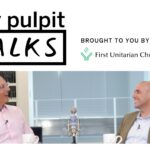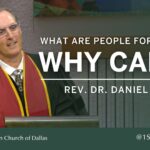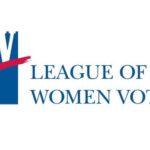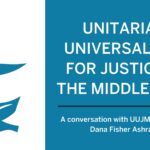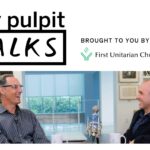First Unitarian Church of Dallas Founded
On May 12 , 1899, at the invitation of Rabbi Dr. George Alexander Kohut, Mr. Daniel Christian Limbaugh gave a talk on the Unitarian religion at Temple Emanu-El.
He said, in part, “The time has come in the history of Dallas when a broad and liberal Christianity should be declared here. Many souls are hungering and thirsting for religious knowledge, truth, and righteousness. To them the old dogmas, doctrines, and creeds appear outgrown. These persons are at sea without a chart or compass, and many are making shipwrecks of their religious natures. The old creeds seem to them unworthy of the character of God, the nature of man, and the highest conception of human duty and destiny. . . We need a liberal platform which does no violence to religion but which, while perfectly rational, is at the same time expressive of the highest conception of a life of spirituality.”
Daniel Limbaugh was invited back several more times to the Temple to speak and during that summer became acquainted with several people who were interested in forming a new church.
On December 3, 1899, after several months of preliminary work, the First Unitarian Church of Dallas was formally organized with thirty-two members. Little could they have imagined that in 100 years the church would grow to over 750 members, and would remain a haven of hope for those “at sea without a chart or compass” for their religious natures.
By 1903 the church had a building, had established a Women’s Alliance Group, adopted a constitution and by-laws, rented an organ and bought hymnbooks. The object of the church, said the constitution, was to “maintain regular services of Christian worship. . . and to upbuild in the hearts of its people the high ideals of a rational, progressive, and exalting religion in the love of God and the service of man.”
A Growing Liberal Religious Community
In 1913 they moved to a larger church at the northeast corner of South Ervay and St. Louis Streets. Rev. Gilmore, who followed several short pastorates, came to be their minister for the next eleven years. The Dramatic Club of the church was established, flourished, and became the nucleus of the Little Theater of Dallas.
In an event unprecedented in the history of Dallas, Rabindranath Tagore, Nobel Prize recipient in literature, poet and philosopher from India spoke at the church in 1921. In his long cream-colored robe and sandals, he gave Dallas, by his presence, a glimpse of a larger world of faith than had been previously experienced. One thousand people heard him at the morning and evening services, with the newspaper reporting over six hundred others turned away.
Years later, in the early 1990s, the Minister of Religious Education, Rev. Norma Veridan, along with leaders at Thanksgiving Square would establish the Multi-Faith Explorations and Exchange program, which would provide opportunities for participants from around the city to visit each other’s churches and learn about their faith and practices, continuing to foster inter-faith understanding and wisdom begun so many years before.
The Depression Years
The church, like many, suffered the shock of the depression years. Unable to support a minister, the church ceased having regular services in 1931, with only the meetings of the Women’s Alliance continuing. Services and activities were not resumed until 1938. The church sold its properties in 1938 and began renting space in Scott Hall in downtown Dallas. While the process of rebuilding the congregation was not easy, the purposes of the church were realized to be more important than ever, and the commitment to its presence in Dallas was solidified.
Rev. Robert Raible & First Church Find a Home on Preston Road
In 1942 Rev. Robert Raible was called to be the minister of the church and began what was to be twenty-two years of growth of membership, strength and effectiveness in serving the city. Rev. Raible and Rabbi Olan, of Temple Emanu-el became close friends and worked tirelessly together to speak to the spirit and soul of the city. Rev. Raible was in demand as a speaker, and was elected President of the Dallas Mental Health Association and the Dallas Council of Human Relations.
In 1944 the church bought land on Preston Road and built what they hoped would be a permanent church home. The chapel, kitchen, wing for classes, offices, library and nursery and a church auditorium were dedicated in 1950 as part of the Southwestern Unitarian Conference meetings.
While plans were being made for the new church, Dr. Raible continued preaching his strong message. He preached that the development of the atomic bomb had changed their lives forever. At Brotherhood Week in 1946 he preached on the fear of strangeness that had created the “loose statements” about minority groups bandied about in Dallas and cautioned against the effects of such statements. He preached that science was not an opponent but a handmaid and servant of religion. He preached in favor of evolution and acceptance of the new field of higher criticism of the Bible. He preached about peace and social justice and the central place of democracy in the Unitarian religion. He preached about the importance of human dignity and the value of each individual.
As soon as the congregation occupied their new church home attendance grew dramatically. By May of 1951 the church had 371 members. The Laymen’s League had sponsored a Boy Scout troop. The library had expanded and several groups in the city made use of the space when it was not in use by the church. Over 275 children were attending the church school on Sundays quickly necessitating the building of more room for the children. Ministerial Interns regularly served the church as part of their training.
The Religious Education building was dedicated in 1955 and Ruth Clark became the educational director, signaling the beginning of a strong period of continuing growth in the church school. Children were taught the stories of the Jewish and Christian tradition as ways to learn strong values for their lives. The adults in the congregation were encouraged to share their lives and their beliefs with the children.
During the week a co-operative nursery school provided care and developmental activities for many of the area’s children. Millie Seltzer, a member of the church directed the nursery school for eleven years.
With two services on Sunday by 1956, a flourishing Single Adults Group and a Married Adults Group, as well as an active Liberal Religious Youth group of young people in High School, the church began to talk of building again. This time it would be a sanctuary large enough to hold the congregation at one time.
Robert Raible, in 1957, preached “Advice to the Dallas School Board”, which was covered in the national press as well as radio and television newscasts. He said the time had come to stop “gradualism” as a method of desegregation and its defiance of the law in postponing racial integration in the schools. Many believe he was instrumental in the desegregation of our school system.
Rev. Dwight Brown Leads Church in Civil Rights and Pro-Choice Efforts
On August 12, 1964 the new sanctuary which would seat 400 people was dedicated. It had been designed by Architect Harwell Hamilton Harris, who described it as “a clearing in the forest.” He thought of it as a place of pause and renewal in the midst of the city, underscoring once again the original purpose of the church to help the people of Dallas to find their way when they are so often without a compass. It was Robert Raible’s last event at the church. He had announced his retirement three years before, and completed his ministry at the dedication of the sanctuary.
Rev. Dwight Brown began his ministry at the church on September 8, 1964. Rev. Brown went with others to Selma, Alabama to show support for Civil Rights. The church became a center of debate and concern during the Viet Nam War and the Russian invasion of Czechoslovakia. Rev. Brown exemplified a reasoned and committed approach to religion. When meetings and services at the church began to be watched by members of the CIA, the church sued and won a public apology. The membership grew to over 850 during this period. In 1969, the Women’s Alliance at the church began to study the issue of Abortion. They invited Virginia Whitehill, a volunteer at Planned Parenthood to speak to them on the issue. Her persuasive and personal talk rallied the women of the Alliance, who had studied the issue for a year and had become convinced that it was a major issue of their time. Deciding to form a group which was larger than their own, and outside the church, they formed a broad coalition of support. With support from the Alliance leadership and Virginia Whitehill, they originally determined only to reform the existing law. It wasn’t long before they realized that the law needed to be repealed, setting the stage for the now well-known Roe v. Wade Supreme Court decision which made abortion legal. Some of the women who participated in the forming of that significant event remain in the church and in the Women’s Alliance today.
Rev. John Buehrens Presides in Precarious Financial Times
Rev. John Buehrens was called to be the Sr. Minister in 1981. Rev. Buehrens, who was later to become the President of the Unitarian Universalist Association, was called “the Rabbi”, his bearded presence and sonorous voice teaching and preaching every Sunday bringing a ‘rabbinical’ presence to the church. He also worked to strengthen the church financially, as the previous two decades of radical individualism in the culture had not promoted financial and institutional strength. The church also became one of the founding congregations of North Dallas Shared Ministries, an emergency food pantry and resource to those in need.
A capital drive in 1985 updated the original buildings and the Religious Education building. Unfortunately the fate of the city’s economy, which was greatly affected by the bank crisis in the mid to late eighties, took its toll on the church. Members were “down-sized” from their jobs and moved away, and the church’s ability to move forward with financial strength was limited. John Buehrens accepted a call to a church in New York City in 1987.
Rev. Laurel Hallman Leads Church Into The New Millennium & Unprecedented Growth
In August 1987, the church called its first female Senior Minister, Laurel Hallman. With a Master of Arts in Divinity degree from the University of Chicago Divinity School and a Doctor of Ministry degree from Meadville Lombard Theological School, she had been minister of the Unitarian Universalist Church of Bloomington, Ind., from 1981 to 1987.
During Rev. Hallman’s ministry the church established a memorial garden and an annual memorial concert, endowed a ministerial internship, initiated the “Journey Toward Wholeness” anti-racism program, established the Multi-Faith Explorations and Exchange program, became a “Welcoming Congregation” for LGBT people, and was a founding congregation of Dallas Area Interfaith, a community organizing group. In the late 1990s we raised $2.1 million for a much-needed renovation of church buildings.
In 1990, when a member wanted to buy a small organ for the congregation in memory of his wife, another member, Stuart Owen, expanded that dream by raising $150,000, in addition to the $40,000 original gift, from the congregation for the Eloise Blatt Memorial Organ, a large Walker pipe organ.
With dynamic preaching and worship, a high-quality religious education program, a comprehensive social justice program, and by helping members and guests connect to the church in meaningful ways, First Unitarian Church grew from about 550 to more than 1,000 members, making it the ninth fastest-growing congregation within the Unitarian Universalist Association (UUA). In 2005 it was named one of the UUA’s Breakthrough Congregations.
In 2003 the Rev. Dr. Daniel Chesney Kanter was called as Associate Minister, adding a second full-time minister to the church’s staff. With a Master of Divinity from Starr King School for the Ministry in Berkeley, California, and a doctorate in ministry from SMU Perkins School of Theology in Dallas, Rev. Kanter had travelled and lived around the world, once hoping to become a Buddhist monk.
In 2005 a $9 million capital campaign was initiated to fulfill the goals of a five-year strategic plan called Chart and Compass 2010. Chart and Compass initiatives have helped us to expand outreach into the larger Dallas community, improve communications, create better religious education facilities, enhance pastoral care for our congregation’s members, and help members develop their spiritual lives. In addition, we have recently completed the construction of about 26,000 square feet of new space for religious education classrooms.
In late 2006, Rev. Hallman announced her intention to retire in January 2009 and run for the UUA presidency. By the end of 2007 Rev. Kanter had been called to become our next senior minister.
Rev. Daniel Kanter Renews Focus on Social Justice and Faith Formation
Under Rev. Kanter’s ministry, the First Unitarian Church of Dallas continues to help its congregants “reach deeper,” with a strong focus on social justice, religious education, interfaith cooperation, and rational dialogue.
The hallmarks of Rev. Kanter’s two decades of ministry at First Unitarian have been innovation in ministry and responsiveness to the needs of a changing world. He is known and interviewed regularly by outlets around the world about reproductive rights grounded in religious principles. His commitment to encourage deeper religious understanding laid the foundation for the Faith Forward program used by dozens of congregations. Rev. Beth Dana, Minister of Faith Development, joined the ministry team in 2015 and made enormous contributions to the breadth and depth of the Faith Forward program and to the ministry the church provides families and people of all ages.
Rev. Daniel led a successful $10 Million dollar capital campaign that culminated in a building project that merged the church’s storied past with its bright future through stunning and architecturally significant buildings and designs. The visionary work of welcoming people digitally for worship and other church events allowed the church to navigate closure and health concerns through the height of the pandemic and emerge with a stronger reach around the country and the world than it had ever had before.
As the largest liberal religious congregation in Dallas and one of the largest Unitarian Universalist congregations in the country, our history lives on today. We remain a progressive oasis in Dallas; a harbor for lost and wandering people without a compass for their religious natures; a place to read, discuss and move against tyrannies of the mind, heart, and body; a treasure of wisdom and strength for our children; a community within which to weather the difficult times and celebrate the joyous times of life; and a voice of reason and challenge in an increasingly conservative religious landscape.


